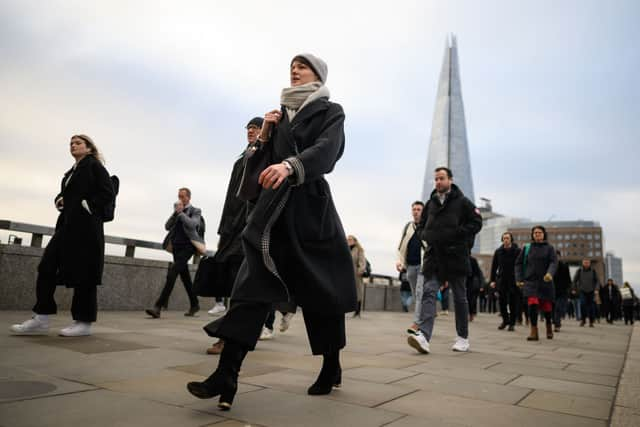UK wage growth: cost of living impact of ONS labour market statistics - effect on inflation, interest rates
and live on Freeview channel 276
One of the key issues during the cost of living crisis so far has been the impact of inflation on household budgets.
Prices have risen so steeply and at such a rapid pace that most incomes have failed to keep up. With the value of savings also having been eaten into, consumer purchasing power has been reduced at a rate not seen since at least the 1970s.
On Tuesday (15 August), the Office for National Statistics (ONS) released its wage statistics for the three months between April and June 2023. Despite recording the largest annual numerical increase in regular pay since records began in 2001, salaries still failed to match inflation over the quarter.
These figures could lead the Bank of England to hike interest rates once again in September due to fears that higher wages may bake higher inflation into the economy. The UK central bank will also base its decision on the next two sets of inflation figures, the first of which is due to be released on Wednesday (16 August).
So what are the latest set of labour market statistics - and what do they mean for you?
What do ONS labour market statistics show?
The latest set of quarterly labour market statistics compiled by the Office for National Statistics (ONS) shows us that regular pay grew 7.8% on average in the three months between April and June 2023.
This figure is made up of a 8.2% increase for private sector workers and 6.2% raise for public sector employees. The sector of the economy which recorded the largest growth overall was finance and business, where average earnings leapt 9.4%.


However, inflation for the period averaged 8.4% on the Consumer Prices Index (CPI). The ONS says it means incomes actually fell 0.6% in real-terms during the quarter compared to the same period in 2022. Put simply, spending power has continued to decrease - albeit, at a lesser rate than it has been during the cost of living crisis so far.
On a slightly more positive note, analysis by the Resolution Foundation has shown real-terms average weekly pay has now surpassed pre-2008 financial crisis levels for the first time outside of the pandemic period. But it is £230 below where it would have been had pre-2008 pay growth trends continued over the intervening 15 years. The think tank also spotted a possible sign of better things to come, as pay data for the month of June specifically showed real wages were higher against the year for the first time in 18 months.
Elsewhere in the ONS statistics, UK unemployment between April and June increased slightly to 4.2%, while the number of vacancies in the economy fell for a thirteenth consecutive month to just over one million. This figure is still well above where it was in the pre-pandemic period.
What do figures mean for the cost of living crisis?
On the face of it, the latest ONS statistics will come as good news to consumers because wages now look likely to move in line with inflation in the near-future, and soon may even surpass it. While this won’t immediately make up for the real-terms drop in incomes we have seen over the last 18-months or so - indeed, that could take several years - purchasing power will be on the road to recovery.
The figures could also prove to be very good news for pensioners. The government’s flagship triple lock policy means the state pension usually goes up each April, with the percentage increase determined by either the inflation (CPI) rate for September, the average wage growth between May and July, or 2.5% - whichever comes out as highest.
Given inflation is expected to fall over the coming months, the next set of ONS wage statistics (set to be released in September) are likely to be the yardstick for 2024’s pension uplift. According to calculations by investment platform Interactive Investor, it could mean the state pension rises 8.2% to £11,469 a year (£220.55 a week) - a near-£17 weekly raise on this year’s rate.


Alice Guy, Interactive Investor’s head of pensions and savings, said: “The rising state pension is great news for pensioners, especially the millions that have no other income apart from the state pension. Pensioners on low incomes have been particularly hard hit by the cost of living crisis and it will be a welcome relief to receive an extra boost next April.”
However, she added that this is unlikely to be good news for the government as the cost of the triple lock could rise by £10 billion in 2024/25. “The current government and Labour party have both committed to the triple lock next year. But the cupboards are bare, with the tax burden at a record level. With an ageing population, the triple lock promise is becoming increasingly expensive,” she said.
The wage growth data is also unlikely to generate much cheer at the Bank of England, whose primary job is to bring inflation down to a rate of 2%. The reason for this is that higher wages are likely to mean spending remains strong in the economy. The more money you have flowing around the economy, the more likely it is that inflation will remain higher for longer - the so-called ‘sticky inflation’ we have heard several warnings about so far in 2023.
Analysts at ING Economics believe the ONS’s findings will “all but cement a September rate hike”. It means interest rates could climb to 5.5% when the Bank of England makes its next announcement on 21 September - a move that could bring more pain to those on variable rate mortgages, like trackers. So, the wage growth figures may hold a sting in the tail for some mortgage payers.
Comment Guidelines
National World encourages reader discussion on our stories. User feedback, insights and back-and-forth exchanges add a rich layer of context to reporting. Please review our Community Guidelines before commenting.
